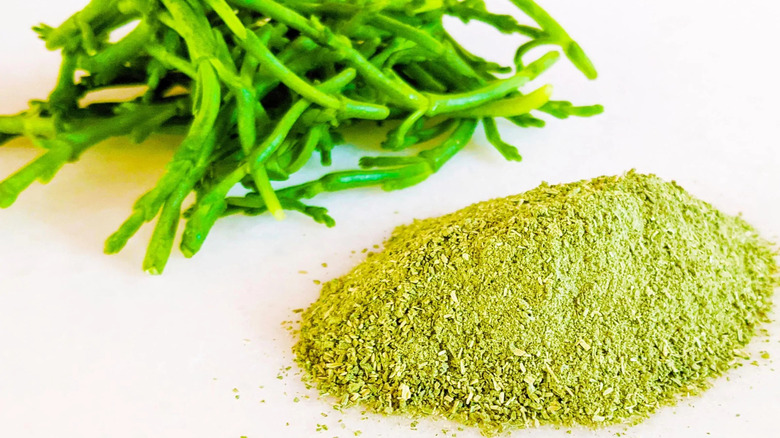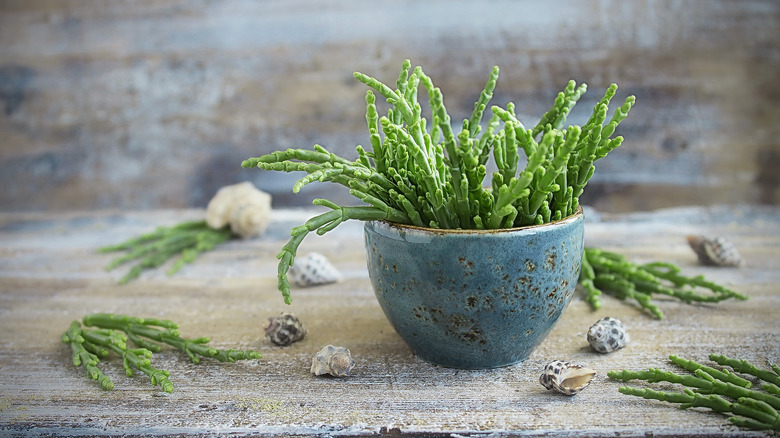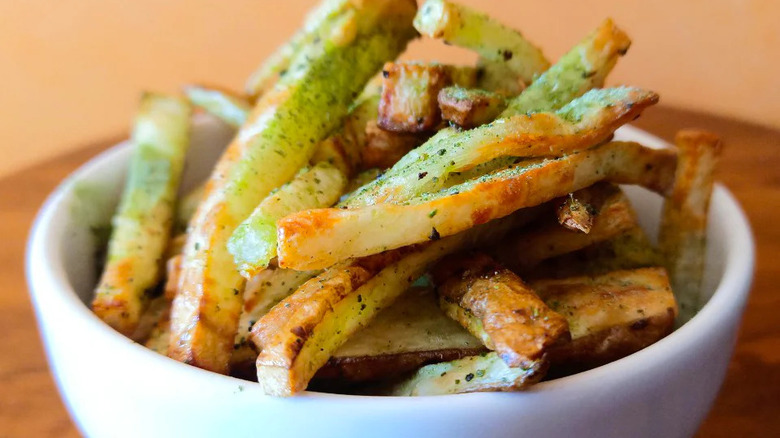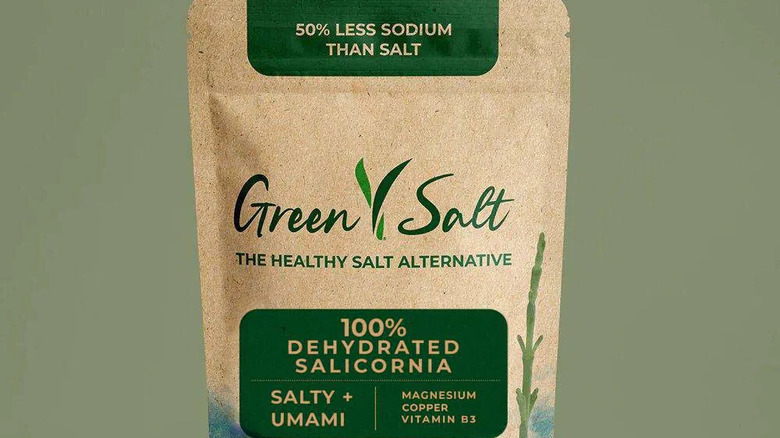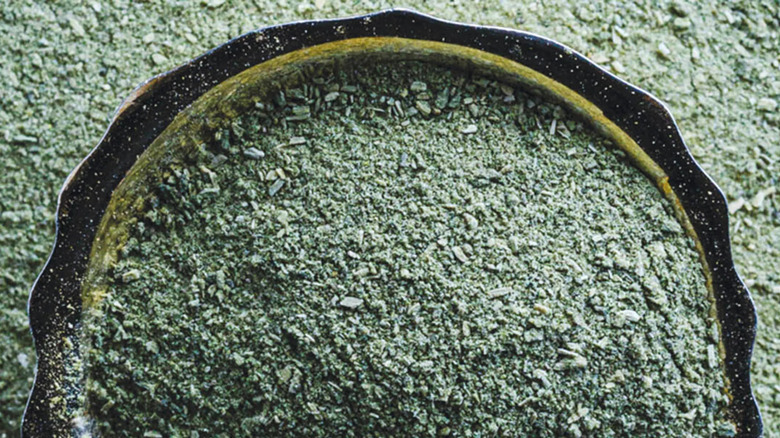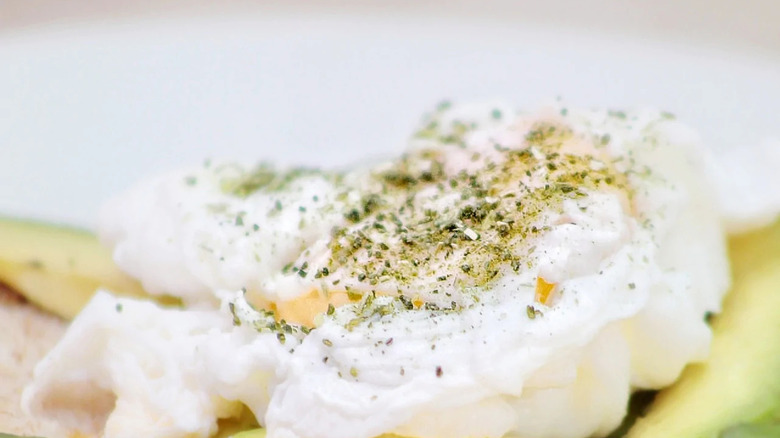What Is Green Salt And Is It Good For You?
As far as salt goes, you may have already discovered a rainbow of culinary possibilities. Himalayan sea salt is naturally pink from its mineral content (impurities and all). Black salt is derived from the salt mines in Pakistan, Bangladash, and Nepal, whereby a heat-induced chemical reaction of the salt, herbs, and charcoal produces its black color. Then there are salts infused with turmeric (and spices), Jalapeno spice, or even green tea — eliciting yellow and green hues. But did you know that there is a type of salt that is naturally green? And no, it's not made from seaweed.
Unlike sea salt or table salt (the most common type of salt), it does not come from evaporated sea water, nor is it derived from halite crystal caves (pure rock salt) to be processed. Green salt is made from a nutrient-dense green sea-side vegetable of the same family as amaranth and quinoa. What makes green salt beneficial is that while it is salty, it actually has 50% less sodium than salt. Read on to explore the origins, nutrition, and plentiful reasons to flavor with green salt.
What is green salt and how is it made?
Green salt is dehydrated, ground "sea asparagus," a vegetable that grows near the sea. It is produced in the golden state: In the marshes of Baja California, resides a flowering halotrophic plant — salicornia — that thrives in high-saline environments. This nutrient-rich plant is responsible for green salt, created by the first commercial producers of salicornia. To be clear, salicornia is not new. This plant has been cultivated in Europe and Asia for hundreds of years, where it has been used in both culinary and medicinal purposes (per 3 Biotech).
The origins of green salt started 20 years ago, when Paul Noriega planted a salicornia field to conserve land in Baja California. Farming salicornia became a family business that continues to honor the values of organic, sustainable farming. Salicornia itself has been sold world-wide, but the Noriega brothers along with co-founder Chris Lin discovered that once ground, dehydrated salicornia also had a place in the market.
Green salt was discovered as a result of dehydrating the salicornia vegetable in order to preserve and not waste the product. In an interview for New Food Magazine, co-founder Chris Lin explained that Salicornia has been harvested from their farms for over a decade, and sold in fine-dining restaurants around the word. "To reduce crop waste, we also dehydrate the product, which extends its shelf life by two-three years. In doing so, we've discovered that dehydrated ground Salicornia can be used as a healthy substitute for sea salt," Lin said.
How to cook with green salt
According to the TryGreenSalt website, green salt may be used just as you would sea salt. As this food enhancer contains absorbed mineral content from the sea, it may have a slightly more "fishy" taste. And while it does not contain any MSG, it can also provide a savory umaminess to your meal. But according to TOWN, green salt doesn't dissolve fully; thus, it is not a good option for tenderizing chicken or beef.
What green salt does best is add flavor to your dishes. It is ideal as a finishing salt, but can also be used for cooking. As the powder is naturally green, it can add a nice garnish to french fries. However, its chlorophyll tint can also stain your baked treats; unless it's St. Paddy's Day, you may not desire a greenish tint to your chocolate chip cookies. (Tip: Add some cocoa powder to give your cookies a more fudge-y look and a chocolate-chocolate chip appeal.)
Where can you buy green salt?
You won't find green salt at Pavillons, Krogers, or Trader Joes — at least, not yet. It's not even available on Amazon. That doesn't mean you can't buy it anywhere; just don't be confused by green tea salt or kelp granules, as the green salt we are referring to is not tea-infused or kelp-derived.
While you may find a "green" salt in certain markets (including Amazon), the only place you can currently buy the salicornia-based green salt is via the company's official website. Admittedly, it is a bit pricey at $22 per seven-ounce bag, or at the discounted price of $19.50 each when you buy two. (And if you are looking for sample sizes, these packets are limited and not typically available.)
But if you've already bought some boutique oils and spices for your foodie desires, you may find that green salt is worth the investment (both culinary- and health-wise).
Benefits and nutritional information
Your body needs but a small amount of sodium to function properly, but it is estimated that the majority of American's over-consume sodium in excess of 1000+ milligrams daily, per the Centers for Disease Control and Prevention. Experts recommend limiting your intake to just 2300 milligrams per day, the same amount in a teaspoon of salt. While it is unlikely that you'd consume an entire teaspoon of salt in one meal, sodium can easily add up through the day. Excess sodium consumption has been attributed to high blood pressure, heart disease, and potentially complications of the liver.
Interestingly, green salt has 50% less sodium than regular salt, and doesn't taste bitter like some salt alternatives (per TryGreenSalt). When used as a finishing salt, it will add a nice dash of color to your dish. Sprinkle it on your popcorn, enjoy a few shakes on crisp, golden potato wedges, or even add it on top of your baked chicken or salmon. The possibilities are limitless.
In addition, salicornia has immune-boosting and antioxidant potential, and is a source of vitamin B3, magnesium, chlorophyll, and potassium. (Note: The potassium levels of green salt are but 10 milligrams per 1.5 grams of green salt – which falls in the safety limits for those with kidney disease.) It's also a decent source of protein and fiber (salt contains neither).
Green salt versus regular salt
While you'll get a distinctive salty flavor from green salt, you won't get the same texture or taste of a traditional mineral-based salt. Green salt may have a bit of seaweed flavor, a type of sea-worthy umaminess that a shake or two of furikake (a seaweed- and sesame-based seasoning) may bring. That's because salicornia grows near (and absorbs minerals from) the sea. That's why dehydrated and ground salicornia is more powder-like, whereas salt granules have a crystalline structure.
How might a powder be more beneficial? In a YouTube interview, TryGreenSalt co-founder Chris Lin explains that green salt doesn't dissolve like traditional salt, which can disappear into your food. He adds that you clearly see the amount of green salt going into your food, giving you better control of just how much you are adding.
Per one-half teaspoon, green salt contains 280 milligrams of sodium –significantly less than the amount in table salt or sea salt (per the USDA). And its added benefit of being 100% salicornia means you get trace amounts of vitamins and minerals (and antioxidant potential) from a plant source. Regular salt, on the other hand, is not plant-derived.
What chefs and home cooks have to say about green salt
According to TryGreenSalt, Michelin star chefs have given green salt their stamp of approval. But what do other chefs and home cooks have to say about it?
Chef AJ loves that green salt is made from a vegetable and has less sodium than traditional salt. "I did use it once in a ranch dressing and you would swear you are tasting salt." Although she swears off salt, she still keeps it on hand because she understands many people like the way salt can enhance their foods.
Dr. Blake Shusterman, a nephrologist (kidney doctor) also known as The Cooking Doc, gave green salt an honest review. He explained that aside from the trace amounts of vitamins and minerals from salicornia, he also appreciates the flavor and lower-sodium content. "(It) takes your food to that extra level because of that extra added (umami) flavor," says Shusterman, adding that it works "really, really well" with eggs. With cucumber, however, green salt "doesn't bring out the crunch or flavor potential that regular salt crystals would bring." He says he had to use twice as much green salt as table salt on avocado to get the same amount of flavor.
Lastly, musician and home cook Chris Hamilton called it "salty, [but] not ultra salty." He recommends going 50/50 with green salt and sea salt to get a better balance of flavor.

